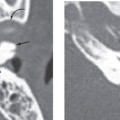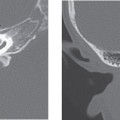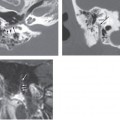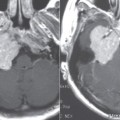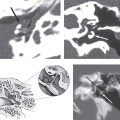CHAPTER 33 Cochlear Malformations
Epidemiology
Congenital deafness accounts for 19% of hearing loss in the population. Bony anomalies associated with a congenital sensorineural hearing loss (SNHL) are fairly uncommon, representing approximately 16 to 20% of the cases of congenital SNHL. The remaining 80 to 84% of congenital SNHL is due to membranous malformation in which the bony architecture of the inner ear is normal. Anomalies of the otic capsule can involve a single structure or the entire capsule. Cochlear malformation can result from an arrest of embryogenesis, abnormal development, or genetic defects that may result in distinctive cochlear anomalies.
Clinical Features
A family history of hearing loss is present in only 12% of the population. Profound SNHL is the presenting symptom that is usually discovered in early childhood, although some patients might have mild, progressive hearing loss. Associated anomalies of the middle ear and cerebrospinal fluid leak/perilymph leak are frequently encountered in these patients (24%). There is an increased risk of recurrent meningitis in patients with congenital temporal anomalies.
Pathology
The inner ear consists of a membranous labyrinth surrounded by an osseous labyrinth or otic capsule. The maturation of the membranous and osseous labyrinth has three main phases: development (4th to 8th week), growth (8th to 16th week), and ossification (16th to 24th week). The development of the sensory epithelium within the membranous labyrinth occurs simultaneously with growth and ossification (8th to 24th week). The membranous labyrinth differentiates from ectodermal primordium, the otic placode, which arises along the lateral aspect of the neural tube. The auditory pit develops from the otic placode during the 4th week, which then invaginates to become the otocyst during the 5th week. The otocyst then divides into a cochlear and vestibular pouch, both of which will later form the various components of the mature membranous labyrinth. The otic capsule develops as a cartilaginous condensation of mesenchyme around the otic vesicle between the 4th and 8th weeks of gestation. Ossification of the otic capsule to form the osseous labyrinth begins at 15 weeks.
The modiolus (Latin for “hub of the wheel”) is the central bony axis about which the spiral canal of the osseous cochlea winds 2½ to 2¾ turns. The interscalar septa are consistently visible on imaging as thin bony projections that connect the inner wall of the cochlea to the modiolus. The osseous spiral lamina of the cochlea is the thin bony shelf that projects from the modiolus and supports the organ of Corti, separating the scala tympani and scala vestibule of cochlea.
Stay updated, free articles. Join our Telegram channel

Full access? Get Clinical Tree


